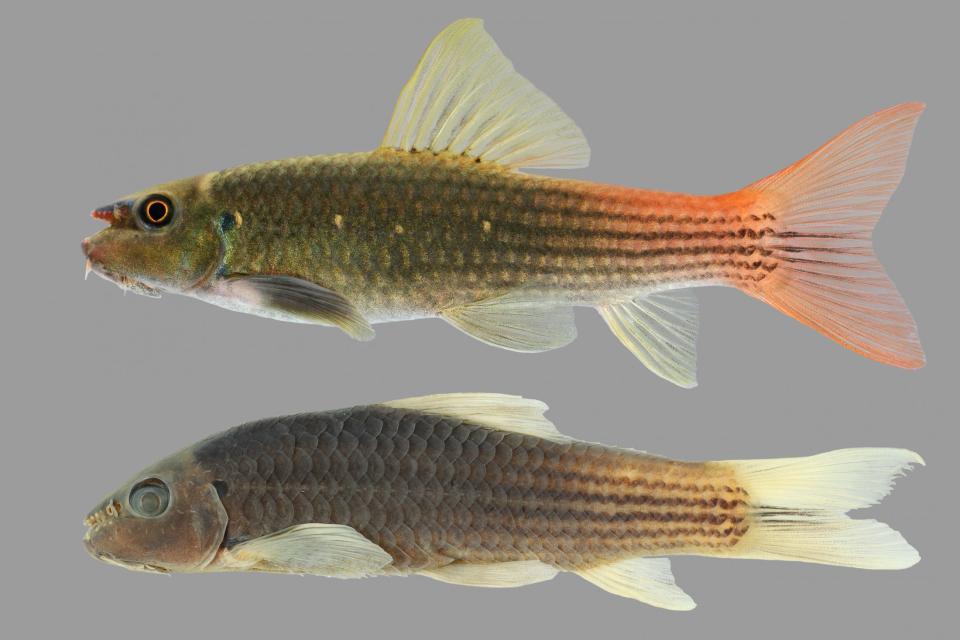This fish has been sold for decades. So, why do Florida scientists say it's a new species?
Researchers from the Florida Museum of Natural History have discovered a new fish species from the genus Garra called the redtail garra, which has been popular in the aquarium trade since the early 2000s.
The fish was discovered by the curator of ichthyology at the Florida Museum of Natural History Larry Page and his colleagues, who named it Garra (panitvongi). That name, Panitvongi, is a tribute to Thai businessman and avid naturalist Nonn Panitvong, who is lauded as a biodiversity hero by the Association of Southeast Asian Nations.
Discovering a new species that has been known for decades might seem strange, but it’s all in the process. While researchers knew of the fish species’ existence, formally discovering the fish requires scientific description based on specimens collected in their natural habitat.
Sawfish tagged in Florida: 13-foot smalltooth sawfish tagged off Florida coast for the first time in 20 years
In other words, ordering a redtail garra online and observing it swimming in a fish bowl wasn’t going to cut it. Researchers needed to find wild redtail garra, which is easier said than done.
Finding the redtail garra

Despite the genus garra being one of the most diverse and widely distributed fish groups anywhere on Earth, this particular species habitate a small stretch of river straddling the border between Thailand and Myanmar, in an area that is isolated and difficult to reach.
Since 2007, Page has annually traveled to Thailand to survey fish, so documenting the redtail garra was simply a matter of time. That time finally came on a recent trip along the Kasat River, a tributary of the Ataran River in neighboring Myanmar.
“When we first collected specimens, we thought it must be widespread in Myanmar because of its popularity in the aquarium trade. But it turns out it’s not. It’s only in the Ataran River basin,” Page said.
Describing the redtail garra
Page and his colleagues published the new species description in the journal Zootaxa, and the fish formally joined nearly 200 other species in the genus garra.
Page says that there is a surprising lack of information about the genus’ natural history given that they are so prevalent throughout the world.
Elephant graveyard found in Florida: 'Once-in-a-lifetime': 5 million-year-old 'elephant graveyard' found in Florida
Basic information about the fishes’ biology is available, but often in the form of studies on individual species or regions, so little is known about relationships or how groups within Garra have diversified, according to Page.
“Most of them live in fast-moving water, and they have a disc-like structure formed from a modification of the lower lip, which they use as an adhesive pad to cling to rocks and maintain their position in the water column as they feed,” he said.
What do redtail garra look like?

Garra primarily subsist on algae and the occasional arthropod, which they eat by scraping detritus off rocks with specialized mouthparts, according to the Florida Museum Like other species in the genus, redtails lack stomachs and have a snout encrusted with modified and hardened scales called tubercles. Similar structures in other fish groups are temporary, often used to defend nests but fall off after the breeding season has ended. Redtail tubercles are permanently attached and seem to be used as weapons, based on aggressive behavior observed in aquaria.
Redtail garra can be distinguished by their unique, elongated snout, covered in even more tubercles, which they can raise or lower, potentially as a means of intimidating opponents during combative encounters. And, as their common name suggests, their tails are emblazoned in red like a signal fire.
Their unique color pattern and their industrious ability to clear away algae have made them a coveted component of aquarium tanks, but their late addition to the roster of scientifically described species underscores a pressing need to take stock of biodiversity in understudied regions.
Redtail garra named after Nonn Panitvong

The redtail garra was named after Thai businessman and avid naturist Nonn Panitvong, who developed a special appreciation for Thailand’s aquatic life from his dad, who took him on fishing trips. Panitvong’s mom also helped nurture his passion for nature by spending time translating books about animals written in English.
Panitvong obtained a Master of Business Administration at the University of North Carolina Wilmington so he could run his family’s sugarcane farm, but when it came time for a doctorate, he opted to study environmental science. After returning to Thailand, he created the website Siamensis.org, an open platform nature enthusiasts could use to share information about Thailand’s flora and fauna and plan excursions to wilderness areas.
In 2006, Panitvong and a friend discovered one of Thailand’s redtail garra populations and helped introduce the fish to the aquarium trade. Now, more than 15 years later, he said the official naming of redtail garra — and the discovery of species like it — help bring the world into clearer focus.
This article originally appeared on Pensacola News Journal: New fish species Redtail garra discovered by Florida researchers

